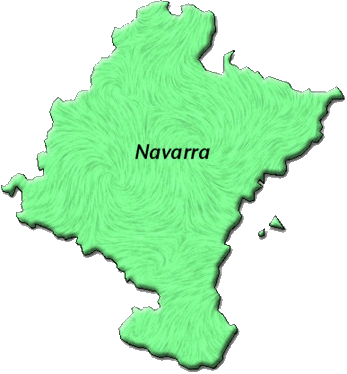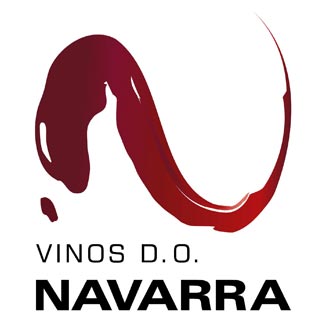Navarre DOs

The Chartered Community of Navarre (Comunidad Foral de Navarra in Spanish; Nafarroako Foru Erkidegoa in Basque) is located in northern Spain, bordering with France on the northeast, the Basque Country in the northwest, La Rioja in the southwest and Aragon in the southeast. Its capital is Pamplona, located more or less in the middle of Navarre, and a great place to visit while in Spain because its a peculiar mix of Basque and Castilian customs.
Wine making in Navarre can be traced back, as with most of the wine making regions in Spain, to the Romans. After the decline of the Roman Empire came the Alans, Vandals and Swabians who entered through France and destroyed everything they found. The vines didn't survive most of this. After them came the Visigoths, but Navarre wasn't much populated by then and their influence was small.
When the Visigoths left, the vines were restored to what they'd been during Roman times. The real expansion of the vineyards producing Navarre wine came with the pilgrims that arrived through the Santiago Way, and the monks who installed their monasteries in the area in the 10th and 11th centuries. Most of the farms or villages that produced wine used it for own consumption, and some used it for trade. The monasteries became agricultural centers, and the monks taught Spanish farmers how to tend to their vines and orchards to produce the best fruits.
During the 15th century, the Navarre wines were at the peak of their production. The vineyards had become the main agricultural activity and income of the farmers. In fact, limitations had to be established because the vines were taking up the place of cereal plantations, and the lack of these was making the price of bread go up, which the monarchs didn't want as it could give way to a rebellion. The excess of Navarre wine was sent to other parts of Spain and Europe through the port of San Sebastián.
The riches collected by some of the farmers who produced and traded their own Navarre wines gave way to the first industrial cellars, which still today are at the top of the Navarre wine production. The phylloxera plague of the 19th century destroyed the French vineyards, so for a while before the plague arrived in Spain, Navarre wines were exported to all of France to make up for their lack of wine. However, this didn't last long, as the phylloxera arrived in Navarre a few months after it devastated France and ate up around 90% of the Navarre vineyards. They were replanted in the 20th century with vines that were resistant to the bug, which was the Spanish course of action for this situation in all the regions that produced wine. The cooperatives started in 1911 and gave way to numerous cellars. The DO was established in 1933 and from there on, the production of Navarre wines has maintained its quality and fame.
DO Navarra

DO Navarra is the only designation of origin that produces Navarre wines. The production zone is divided in five main areas:
- Baja Montaña: found in the east of Navarre, bordering with Aragon. Around 60% of the vines are of the Garnacha variety, 25% of the Tempranillo variety. The climate is humid in the north and dryer in the south of the area.
- Tierra Estella: This area lies to the west of Navarre, bordering with the Basque Country and La Rioja. Around 50% of the vines are of the Tempranillo variety, and 20% belong to Cabernet Sauvignon. There's a smaller percentage of Chardonnay. The climate is humid in the north and dryer in the south of the area.
- Ribera Alta: This are is located in the middle-south of Navarre. Most of the vines belong to the Tempranillo variety, but there's also a percentage of Chardonnay and Moscatel. The climate here is warmer because it doesn't get any of the Atlantic influences the areas in the north do.
- Ribera Baja: Found in the south of Navarre, in the Ebro valley bordering with Aragón and La Rioja. Around 40% of the vines are of the Tempranillo variety, and 30% belong to the Garnacha. In whites there's mainly Moscatel and Viura. The climate in this are is quite arid with little rainfall.
- Valdizarbe: This are is right in the middle of Navarre, where the Santiago Way crosses. Tempranillo, Garnacha, Cabernet and Merlot share more or less the same percentage of vines, and there's also a presence of Chardonnay and Malvasía. This is the most humid zone in all of the production areas of Navarre wines.
Historically, Navarre has been known for its excellent production of rosé wines, but the red Navarre wines have been quite acclamated in the later years. The alcohol contents in these wines is:
- Red: Minimum alcohol content of 11.5%
- White: Minimum alcohol content of 10.5%
- Rosé: Minimum alcohol content of 11%
- Moscatel: Minimum alcohol content between 15% and 18%.
Apart from their excellent wines, Navarre has quite a few historic sites you may want to visit if you're ever in the area, as they provide a clear picture of Spanish culture and traditions.
Spanish Wine History
Spanish Wine Regions and DO
Spanish Wine Tours
Top Spanish designations of origin
Best Spanish Wines
Spanish Wine Production
Spanish Wine Types
Spanish Grapes
Spanish Sparkling Wine: Cava
Sherry Wine
Spanish Wine Cocktails
Spanish Wines in the World
Spanish Wine Prizes
Enotourism
Spanish spirits and liquors
Argentina Wines
Chilean Wines
Other sites